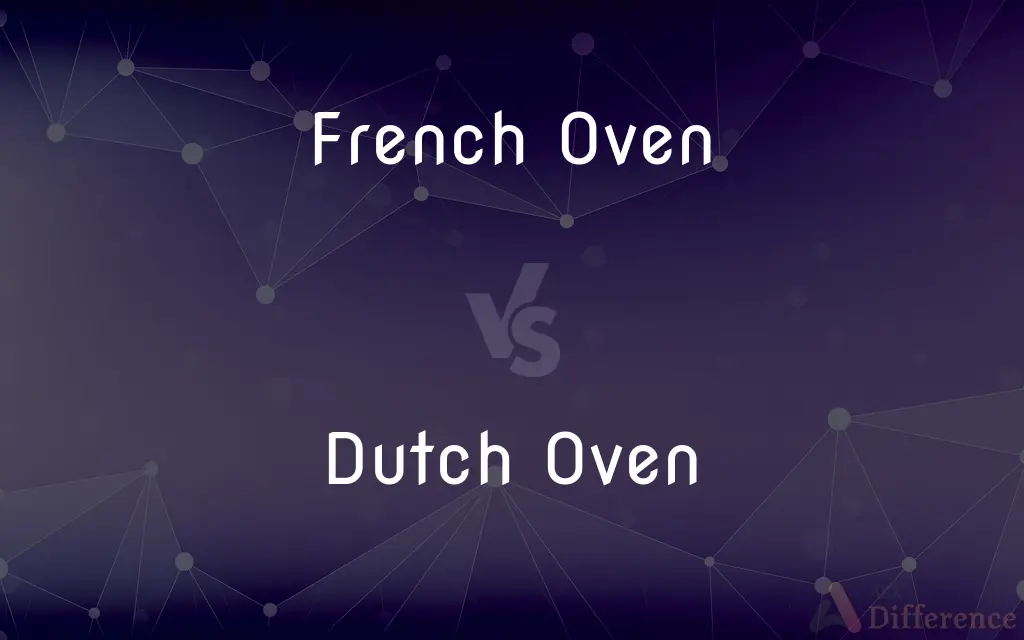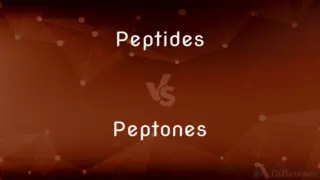French Oven vs. Dutch Oven — What's the Difference?
By Tayyaba Rehman — Published on November 1, 2023
A French Oven is a type of enameled cast iron cookware, often associated with upscale brands. A Dutch Oven is a general term for thick-walled cooking pots, which can be bare or enameled cast iron.

Difference Between French Oven and Dutch Oven
Table of Contents
ADVERTISEMENT
Key Differences
Both French Ovens and Dutch Ovens are staples in many kitchens, renowned for their heat retention and even cooking. However, distinctions arise primarily from branding and specific design features.
The term French Oven often refers to enameled cast iron cookware and is commonly associated with high-end kitchen brands from France. This type of oven typically has a smooth enamel finish on the interior and exterior. On the other hand, a Dutch Oven is a broader term for a heavy-duty pot that has thick walls and a tight-fitting lid. Its history traces back to original casting methods in Pennsylvania.
Functionally, both French Ovens and Dutch Ovens can perform similarly in the kitchen. They're both ideal for slow cooking, braising, roasting, and even baking bread. Yet, while all French Ovens are essentially Dutch Ovens, not all Dutch Ovens have the specific characteristics of a French Oven, particularly the enamel coating.
Some believe the term French Oven arose as a marketing strategy to differentiate certain brands or designs from traditional Dutch Ovens. Regardless of naming, both types of ovens have their merits and are beloved by chefs and home cooks alike for their versatility and durability.
Comparison Chart
Origin of the term
Associated with upscale French brands
Generic term with origins in Pennsylvania
ADVERTISEMENT
Coating
Typically enameled both inside and out
Can be bare or enameled cast iron
Association
High-end kitchenware
Broad category of heavy-duty cook pots
Price point
Often more expensive due to branding
Can range from affordable to high-end
Specificity
A type of Dutch Oven with certain characteristics
General term for thick-walled cooking pots
Compare with Definitions
French Oven
Commonly used for slow-cooking gourmet dishes.
Her beef bourguignon cooked perfectly in the French Oven.
Dutch Oven
Ideal for stews, braises, and slow-cooked dishes.
The chili cooked evenly in the Dutch Oven, developing rich flavors.
French Oven
Associated with luxury kitchen brands.
She splurged on a French Oven from a renowned European brand.
Dutch Oven
A kitchen staple with roots in traditional cookery.
Her grandmother's recipes often called for a Dutch Oven.
French Oven
A Dutch Oven variant with enamel coating.
The creamy interior of the French Oven ensured the food didn't stick.
Dutch Oven
A thick-walled cooking pot with a tight lid.
She simmered the soup all day in her cast iron Dutch Oven.
French Oven
An enameled cast iron cookware piece.
The beautiful blue French Oven became the centerpiece of her kitchen.
Dutch Oven
Can be made of bare or enameled cast iron.
His Dutch Oven had a natural finish, requiring seasoning after each use.
French Oven
Thick-walled pot, often from upscale manufacturers.
The wedding registry prominently featured a designer French Oven.
Dutch Oven
Renowned for heat retention and even cooking.
Baking bread in a Dutch Oven yielded a fantastic crust and moist interior.
Common Curiosities
Can you use a French Oven on any heat source?
Generally, yes; most French Ovens are compatible with all heat sources, but always check manufacturer guidelines.
Is the French Oven just a fancy Dutch Oven?
Essentially, a French Oven is a specific type of Dutch Oven, often associated with upscale brands and an enamel finish.
Can I bake bread in both the ovens?
Yes, both the French Oven and Dutch Oven are excellent for baking bread due to their heat retention.
Why is the Dutch Oven called "Dutch"?
The name traces back to a casting technique developed by an Englishman, Abraham Darby, who learned it from the Dutch.
Are French Ovens more expensive than Dutch Ovens?
Often, French Ovens are pricier due to branding, but prices for Dutch Ovens can also vary based on brand and material.
Is seasoning required for a French Oven?
No, the enamel coating on a French Oven eliminates the need for seasoning, unlike some bare cast iron Dutch Ovens.
What's the primary material of a French Oven?
A French Oven is typically made of enameled cast iron.
Is a Dutch Oven always enameled?
No, a Dutch Oven can be either bare or enameled cast iron.
Can a Dutch Oven be used on a campfire?
Yes, especially the bare cast iron Dutch Ovens are suitable for campfire cooking.
Which is better for long, slow cooking?
Both the French Oven and Dutch Oven are excellent for slow cooking because of their heat retention capabilities.
Are Dutch Ovens part of traditional American cookery?
Yes, Dutch Ovens have been a staple in American kitchens for centuries, especially for pioneer and frontier cooking.
Is there a weight difference between the two?
Both can be quite heavy, but the weight primarily depends on the size and specific brand rather than whether it's a French or Dutch Oven.
Which oven is more versatile?
Both ovens are highly versatile, but some might argue Dutch Ovens have an edge due to the option of bare or enameled surfaces.
How do I maintain the longevity of my French Oven?
Avoid sudden temperature changes, use wooden or silicone utensils to prevent scratching, and hand wash with mild soap.
Why do some prefer the enamel coating of a French Oven?
The enamel coating prevents rusting, doesn't require seasoning, and can be easier to clean.
Share Your Discovery

Previous Comparison
Short Term Goals vs. Long Term Goals
Next Comparison
Peptides vs. PeptonesAuthor Spotlight
Written by
Tayyaba RehmanTayyaba Rehman is a distinguished writer, currently serving as a primary contributor to askdifference.com. As a researcher in semantics and etymology, Tayyaba's passion for the complexity of languages and their distinctions has found a perfect home on the platform. Tayyaba delves into the intricacies of language, distinguishing between commonly confused words and phrases, thereby providing clarity for readers worldwide.












































